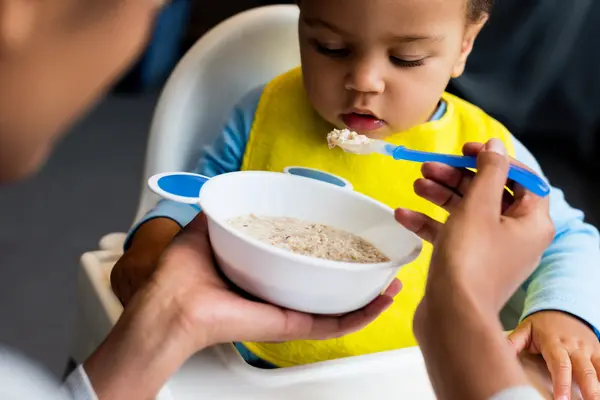In the United States, many people haven’t heard of the ancient and effective practice of baby massage. When done daily and correctly, massaging your baby can alleviate gas and colic; improve sleep, congestion, digestion, circulation, and immunity; increase body and brain growth; decrease postpartum depression; improve the breastfeeding relationship; and reduce crying by 50 percent. And that’s just the beginning of the benefits! But there are a few do’s and don’ts to know when massaging your baby.
Being Indian, baby massage is a part of my culture and has been practiced in my family for generations. Every baby deserves and needs to be massaged every day. When I hear that someone hasn’t heard of baby massage, is afraid of hurting their baby, or doesn’t believe it is critical, my passion to spread the knowledge deepens.
I’ve been teaching baby massage classes to families in the Washington, D.C. area and virtually for two years. I’m amazed at the progress that babies make and the sense of empowerment that mamas feel. We rely so heavily on medical interventions, often feeling helpless when our babies are struggling with common ailments. Baby massage also provides benefits for the parents, as they release oxytocin during the massage and strengthen their skills as parents.
View this post on Instagram
When I was training to be a baby massage instructor, I used the strokes on my daughter each week I was learning them. I, too, didn’t believe they would be as effective as they were. But, when I saw the immediate effect of a baby massage for gas relief, I felt so empowered and confident.
Like exercising or eating healthy, the effectiveness of massaging your baby is revealed when it is practiced on a regular basis. The best time to learn is when you’re pregnant, so that once your baby is born, you are ready to start massaging. The fourth trimester is the best time to put your skills to work since it is during this time that your baby will be experiencing issues like gas, colic, sleeplessness, colds, and congestion.
Massaging a baby is not hard, but it is important to learn the proper techniques, context, nuances, and cues. You should also be aware of misinformation. For example, I recently came across a video sponsored by a well-known diaper brand, showing a mother massaging her baby the wrong way. The stroke demonstrated was said to alleviate gas/colic, but instead it could cause a baby to projectile vomit! That is not what we want. I was concerned by the misinformation parents could find when they take to Google (like all parents tend to do), so I’ve compiled this list of do’s and don’ts.
5 Do’s and Don’ts of Baby Massage
Do:
1. Understand the importance, effectiveness, and criticalness of baby massage
Baby massage has been practiced for thousands of years to address everything from gas/colic and sleep to immunity, growth, bonding, circulation, breastfeeding, postpartum depression, and more. It is not a luxury or a nice thing to do, but rather critical to the short-term and long-term health of your baby. It’s as essential as food and water.
2. Determine the right time to massage your baby
The Active Alert state is the best time to massage a baby. It is when the baby has rested, eaten, and is in a state of curiosity and observation, open to receiving a massage.
3. Learn the proper form and techniques
While massaging your baby is straightforward, it must be done using proper form and technique so as not to harm the baby or cause the opposite effect of what was intended. Consider attending baby massage classes or hiring a baby massage instructor.
4. Make baby massage a daily activity, not a one-and-done event
Similar to any health habit, the benefits of baby massage can only be seen if it is practiced on a regular basis for at least 10-15 minutes a day. Set aside a specific time each day to massage your baby.
5. Make an experience out of it
Baby massage can be fun, relaxing, and rewarding for all of those involved. Set the scene by turning on soft music and lighting candles.
Don’t:
1. Get overwhelmed by the addition of a new activity
Baby massage can be easily and quickly incorporated into your daily routines, whether it’s at playtime, bath time, or bedtime. It shouldn’t be stressful or cumbersome. It should be an enjoyable experience for both you and your baby.
2. Overlook massaging baby correctly and safely
Understanding the proper time, cues, environment, and nuances will help make the massage safe and successful. If you’ve taken baby massage classes, you will known proper techniques and should be able to identify misinformation.
3. Underestimate the power of baby massage to relieve the most common ailments
Baby massage is especially effective for gas relief, colic, sleeplessness, and congestion. Using it to help with these common ailments reduces the need for unnecessary medical intervention.
4. Push through the massage session if baby is unhappy
You want the experience to be positive for you and your baby, so don’t feel like you have to continue the massage if your baby is crying or cranky. No one will enjoy it and your baby will begin to create a negative association with it.
5. Feel like you have to massage baby for 20 or 30 minutes a day
Just 15 minutes of baby massage a day for one month increases white blood cells, strengthening your baby’s immune system. It’s a quick and effective tactic that can have benefits for years to come.
For more information and support on baby massage, visit Vyana Infant Massage. When you join the email list, you’ll have access to a free cheat sheet on baby massage oils by season. You’ll also get an informational video on alleviating constipation. You can also find us on Facebook or Instagram.





